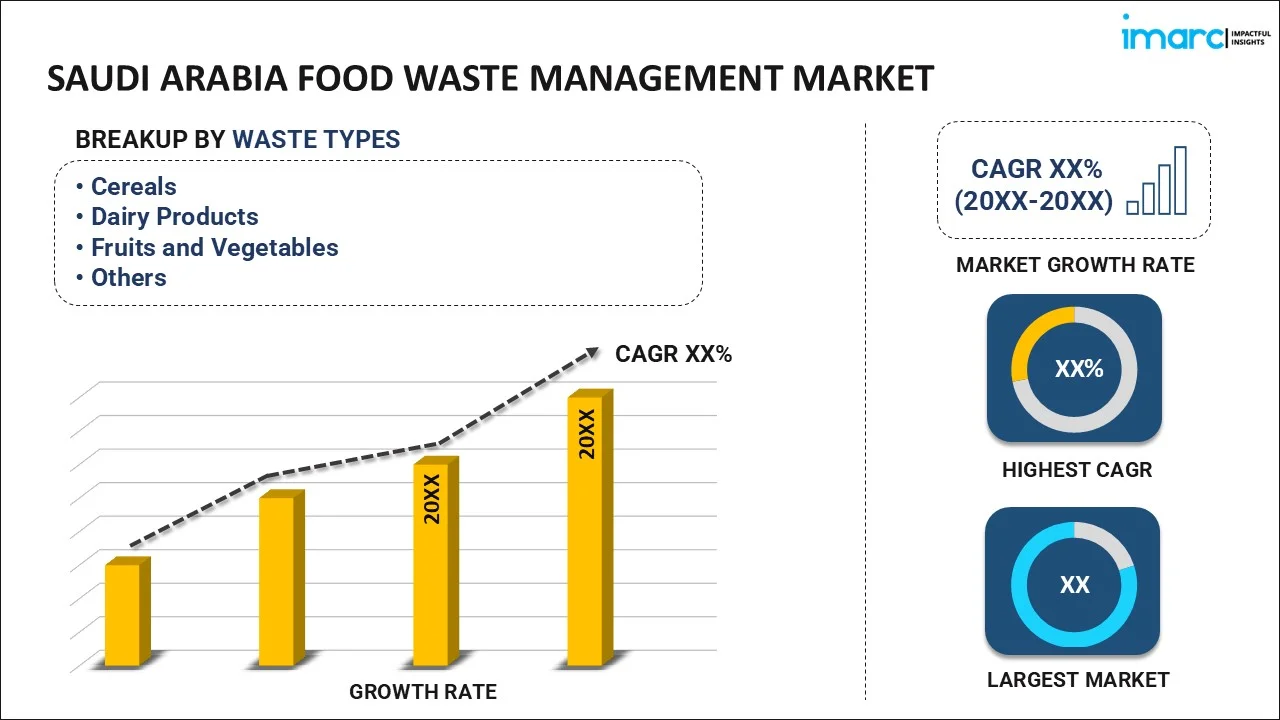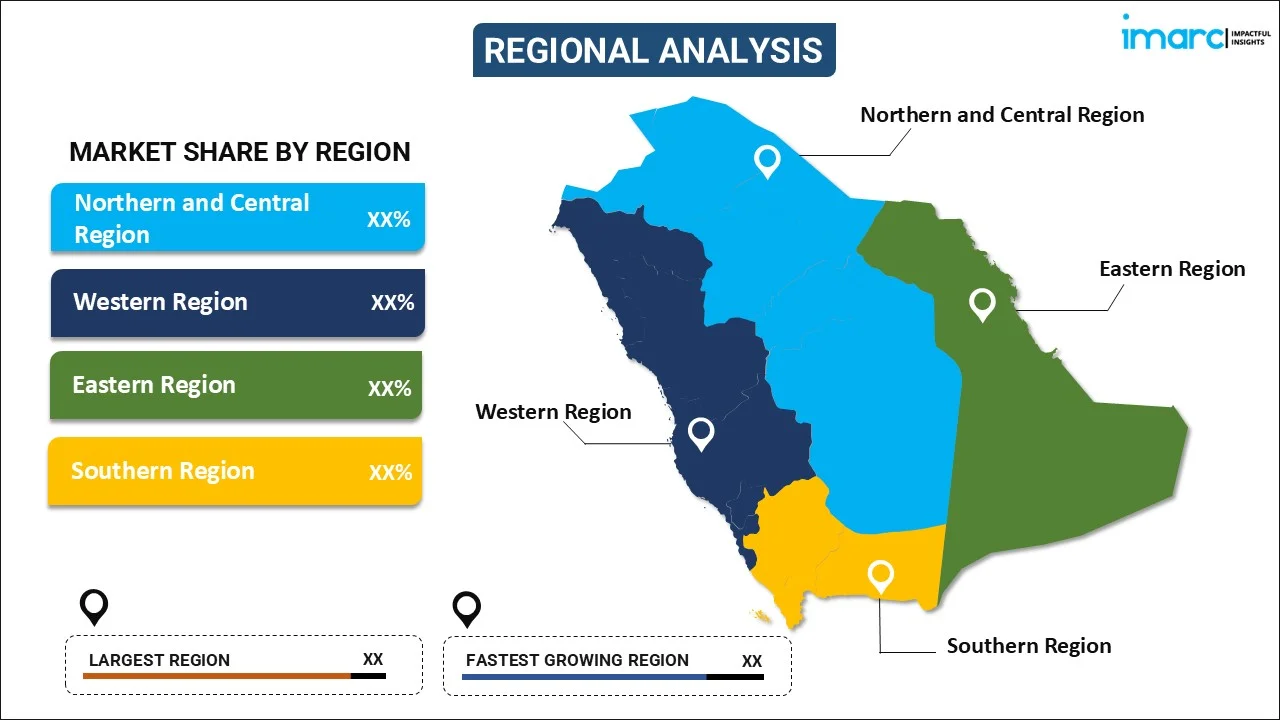
Saudi Arabia Food Waste Management Market Size, Share, Trends and Forecast by Waste Type, Process, Source, Application, and Region, 2025-2033
Saudi Arabia Food Waste Management Market Overview:
The Saudi Arabia food waste management market size reached USD 0.73 Billion in 2024. Looking forward, IMARC Group expects the market to reach USD 1.15 Billion by 2033, exhibiting a growth rate (CAGR) of 5.25% during 2025-2033. The growing government initiatives to reduce waste, an increasing awareness of environmental sustainability, a shift toward resource optimization, rapid urbanization, and high food consumption are some of the major factors positively impacting the Saudi Arabia food waste management market share.
|
Report Attribute
|
Key Statistics
|
|---|---|
|
Base Year
|
2024
|
|
Forecast Years
|
2025-2033
|
|
Historical Years
|
2019-2024
|
| Market Size in 2024 | USD 0.73 Billion |
| Market Forecast in 2033 | USD 1.15 Billion |
| Market Growth Rate (2025-2033) | 5.25% |
Saudi Arabia Food Waste Management Market Trends:
Government Initiatives and Policies
The Saudi government has been proactive in implementing strategies to reduce food waste, aligned with its Vision 2030 goals to promote environmental sustainability. Programs aimed at reducing landfill use and encouraging recycling and waste segregation further boosts the demand for food waste management solutions. Additionally, partnerships between government and private sectors, along with campaigns promoting efficient food use, create a supportive framework for the Saudi Arabia food waste management market growth. For instance, in March 2024, at a ceremony held in conjunction with the recent International Day of Zero Waste festivities in Riyadh, the strategic programs of the Grace Preservation Foundation were introduced. In Saudi Arabia, several programs had been started to reduce food waste. The program also emphasized how important it is to increase public awareness of the negative effects that food waste has on the economy, society, and environment. Additionally, officials unveiled the Grace Preservation app and platform, which provides a range of services to organizations in the food service sector and the public. The platform facilitates donations to the foundation's programs, enabling and promoting long-term expansion in the food preservation industry.
Rising Environmental Awareness
With growing concerns over environmental degradation and sustainability, there has been an increased focus on minimizing food waste across industries and households. The awareness of food waste’s impact on greenhouse gas (GHG) emissions and resource depletion leads to higher demand for effective waste management solutions. As consumers and businesses become more conscious of their ecological footprints, waste minimization and recycling programs are gaining traction, which is positively influencing Saudi Arabia food waste management market outlook. For instance, in March 2023, Saudi Arabia started an awareness campaign to encourage people to cut back on trash and be more frugal during the holy month of Ramadan. The "With Frugality, It Lasts" campaign was started by the National Program to Reduce Food Loss and Waste to increase awareness of the significance of reducing food waste and excess during Ramadan. In Saudi Arabia, food waste was projected to be approximately 33%, or SR40 Billion annually. The campaign's objectives are to use natural resources, promote the preservation of the nation's food wealth, increase awareness of the diseases caused by food waste, and emphasize the value of a diverse diet.
Saudi Arabia Food Waste Management Market Segmentation:
IMARC Group provides an analysis of the key trends in each segment of the market, along with forecasts at the country level for 2025-2033. Our report has categorized the market based on waste type, process, source, and application.
Waste Type Insights:

- Cereals
- Dairy Products
- Fruits and Vegetables
- Fish and Sea Food
- Processed Food
- Others
The report has provided a detailed breakup and analysis of the market based on the waste type. This includes cereals, dairy products, fruits and vegetables, fish and sea food, processed food, and others.
Process Insights:
- Primary Food Producers
- Food Manufacturers
- Food Distributors and Suppliers
- Food Service Providers
- Municipalities and Households
A detailed breakup and analysis of the market based on the process have also been provided in the report. This includes primary food producers, food manufacturers, food distributors and suppliers, food service providers, and municipalities and households.
Source Insights:
- Cereals
- Dairy Products
- Fruits and Vegetables
- Fish and Sea Food
- Processed Food
The report has provided a detailed breakup and analysis of the market based on the source. This includes cereals, dairy products, fruits and vegetables, fish and sea food, and processed food.
Application Insights:
- Animal Feed
- Fertilizer
- Biofuel
- Power Generation
A detailed breakup and analysis of the market based on the application have also been provided in the report. This includes animal feed, fertilizer, biofuel, and power generation.
Regional Insights:

- Northern and Central Region
- Western Region
- Eastern Region
- Southern Region
The report has also provided a comprehensive analysis of all the major regional markets, which include Northern and Central region, Western region, Eastern region, and Southern region.
Competitive Landscape:
The market research report has also provided a comprehensive analysis of the competitive landscape. Competitive analysis such as market structure, key player positioning, top winning strategies, competitive dashboard, and company evaluation quadrant has been covered in the report. Also, detailed profiles of all major companies have been provided.
Saudi Arabia Food Waste Management Market News:
- September 2023: A USD 1.5 Million investment was secured by the unique online marketplace Barakah, which announced the successful conclusion of its seed funding round. In just ten months, Barakah has prevented over 100,000 meals from going to waste by revolutionizing the way bakeries, restaurants, and grocery stores monetize their excess inventory. This is due to its quickly expanding base of food retailers and consumers.
- October 2024: An event of the International Day of Awareness of Food Loss and Waste was organized in collaboration with UNDP Saudi Arabia and the Balad Alkhieer Endowment Foundation. The occasion highlighted the significance of sustainable development and environmental waste management in the run-up to UNCCD COP16. The manufacture of biofuel from trash, recycling programs for agricultural waste, and legislative initiatives promoting sustainable practices in Saudi Arabia were among the major projects on display.
Saudi Arabia Food Waste Management Market Report Coverage:
| Report Features | Details |
|---|---|
| Base Year of the Analysis | 2024 |
| Historical Period | 2019-2024 |
| Forecast Period | 2025-2033 |
| Units | Billion USD |
| Scope of the Report |
Exploration of Historical Trends and Market Outlook, Industry Catalysts and Challenges, Segment-Wise Historical and Future Market Assessment:
|
| Waste Types Covered | Cereals, Dairy Products, Fruits and Vegetables, Fish and Sea Food, Processed Food, Others |
| Processes Covered | Primary Food Producers, Food Manufacturers, Food Distributors and Suppliers, Food Service Providers, Municipalities and Household |
| Sources Covered | Cereals, Dairy Products, Fruits and Vegetables, Fish and Sea Food, Processed Food |
| Applications Covered | Animal Feed, Fertilizer, Biofuel, Power Generation |
| Regions Covered | Northern and Central Region, Western Region, Eastern Region, Southern Region |
| Customization Scope | 10% Free Customization |
| Post-Sale Analyst Support | 10-12 Weeks |
| Delivery Format | PDF and Excel through Email (We can also provide the editable version of the report in PPT/Word format on special request) |
Key Questions Answered in This Report:
- How has the Saudi Arabia food waste management market performed so far and how will it perform in the coming years?
- What is the breakup of the Saudi Arabia food waste management market on the basis of waste type?
- What is the breakup of the Saudi Arabia food waste management market on the basis of process?
- What is the breakup of the Saudi Arabia food waste management market on the basis of source?
- What is the breakup of the Saudi Arabia food waste management market on the basis of application?
- What is the breakup of the Saudi Arabia food waste management market on the basis of region?
- What are the various stages in the value chain of the Saudi Arabia food waste management market?
- What are the key driving factors and challenges in the Saudi Arabia food waste management?
- What is the structure of the Saudi Arabia food waste management market and who are the key players?
- What is the degree of competition in the Saudi Arabia food waste management market?
Key Benefits for Stakeholders:
- IMARC’s industry report offers a comprehensive quantitative analysis of various market segments, historical and current market trends, market forecasts, and dynamics of the Saudi Arabia food waste management market from 2019-2033.
- The research report provides the latest information on the market drivers, challenges, and opportunities in the Saudi Arabia food waste management market.
- Porter's five forces analysis assist stakeholders in assessing the impact of new entrants, competitive rivalry, supplier power, buyer power, and the threat of substitution. It helps stakeholders to analyze the level of competition within the Saudi Arabia food waste management industry and its attractiveness.
- Competitive landscape allows stakeholders to understand their competitive environment and provides an insight into the current positions of key players in the market.
Need more help?
- Speak to our experienced analysts for insights on the current market scenarios.
- Include additional segments and countries to customize the report as per your requirement.
- Gain an unparalleled competitive advantage in your domain by understanding how to utilize the report and positively impacting your operations and revenue.
- For further assistance, please connect with our analysts.
 Inquire Before Buying
Inquire Before Buying
 Speak to an Analyst
Speak to an Analyst
 Request Brochure
Request Brochure
 Request Customization
Request Customization




.webp)




.webp)












